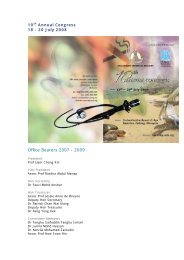download - Malaysian Thoracic Society
download - Malaysian Thoracic Society
download - Malaysian Thoracic Society
You also want an ePaper? Increase the reach of your titles
YUMPU automatically turns print PDFs into web optimized ePapers that Google loves.
Annual Congress of <strong>Malaysian</strong> <strong>Thoracic</strong> <strong>Society</strong><br />
OP 10<br />
Health-Related Quality Of Life Among COPD Patients In Universiti<br />
Kebangsaan Malaysia Medical Center (UKMMC) Using New Assessment<br />
Tool – COPD Assessment Test (CAT)<br />
Hazman Jalil, Alia Suzana Asri, Huan Kai Poh, Ng Sock Wen, Ramlah Mohamad Kutty,<br />
Roslina A Manap<br />
Department of Internal Medicine, Faculty of Medicine, Universiti Kebangsaan Malaysia Medical Centre,<br />
Kuala Lumpur, Malaysia<br />
Introduction<br />
The COPD Assessment Test is a new patient- completed instrument that has been designed to provide a<br />
simple and reliable measure of health status in COPD patients. The questionnaire consists of eight questions<br />
which enquire about symptoms and their impact on COPD patients.<br />
Objective<br />
The aim of this cross-sectional study was to assess health-related quality of life amongst COPD patients in<br />
UKMMC using the CAT.<br />
Methodology<br />
Consecutive stable COPD outpatients aged 18 years old and above, diagnosed for at least 6 months were<br />
assessed during clinic visits. Validated English, Bahasa Malaysia and Mandarin versions of CAT. were used.<br />
Results<br />
Fifty patients (39 male, 11 female) were recruited. Forty-eight percent were Malay, 40% Chinese, and 12%<br />
Indian. Mean patient age was 69 (48 – 87) years. A majority of patients were less educated (less educated<br />
vs educated, 58% vs 42%), had low monthly income (low vs high, 88% vs 12%) and most (64%) had a long<br />
duration of illness (> 3 years). Seventy-six percent of the subjects were ex-smokers, 14% never smoked and<br />
10% were current smokers. Mean FEV1 was 1.22L (0.4 to 2.4L), (n=18). There were 19 patients enrolled in<br />
pulmonary rehabilitation.<br />
Most (52%) patients had low scores (30) disease impact. The most common symptom was cough (92%)<br />
followed by dyspnoea (84%), phlegm (80%), low energy (74%), limited home activities (56%), chest tightness<br />
(54%) and sleep disturbance (54%). Nonetheless, the majority (64%) of them had confidence in leaving home<br />
despite their lung disease. There was no significant association between age, duration of illness or smoking<br />
status and the CAT score. Our study revealed that patients who underwent pulmonary rehabilitation had a<br />
better quality of life than patients who were not in the programme (p=0.04, ANOVA).<br />
Conclusion<br />
The CAT is a patient-friendly and easy-to-use assessment tool that can be practically utilized in clinic<br />
and research. Nonetheless, patients need encouragement and reassurance that the answers are entirely<br />
dependent on them. Generally, the health status of UKMMC COPD patients was acceptably good. Patients<br />
who involved in pulmonary rehabilitation reported a significantly better quality of life.<br />
57








